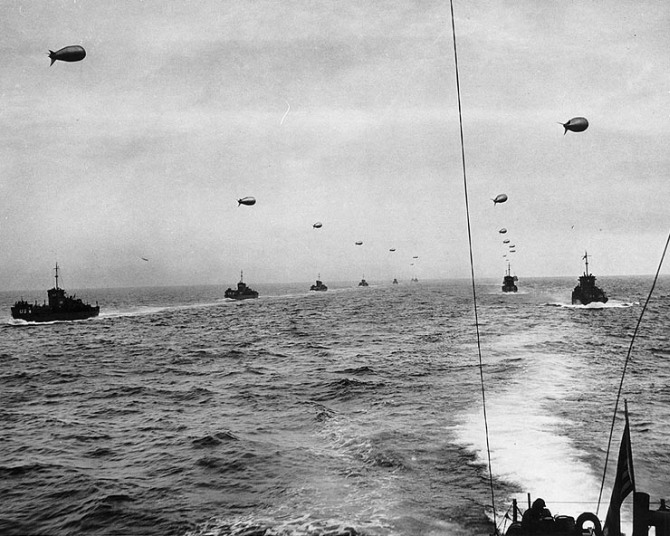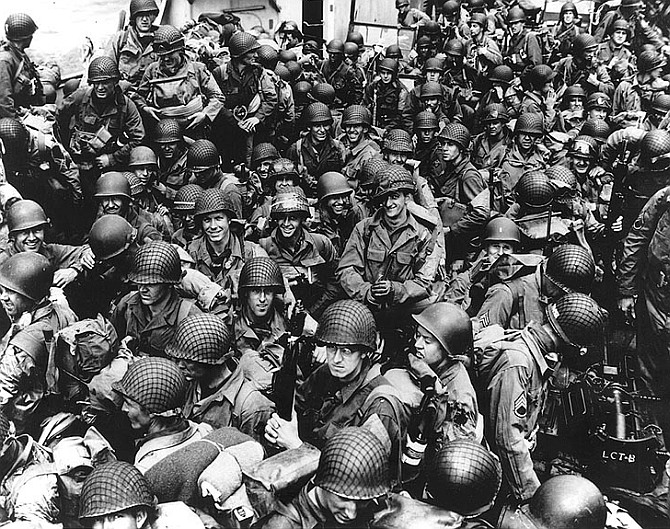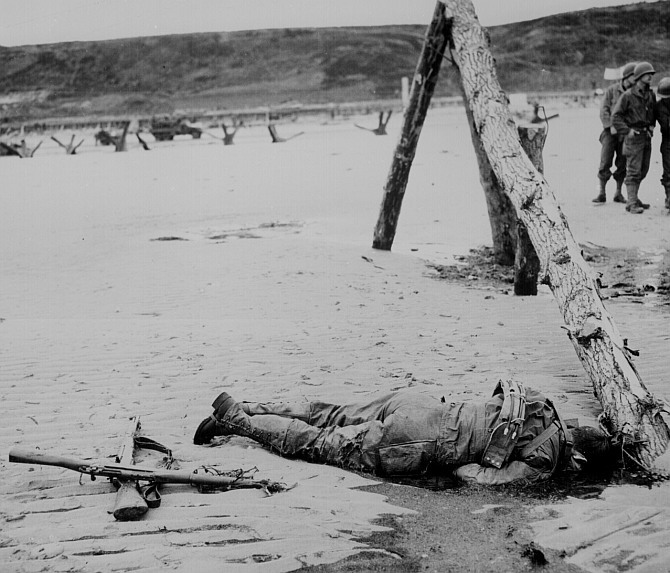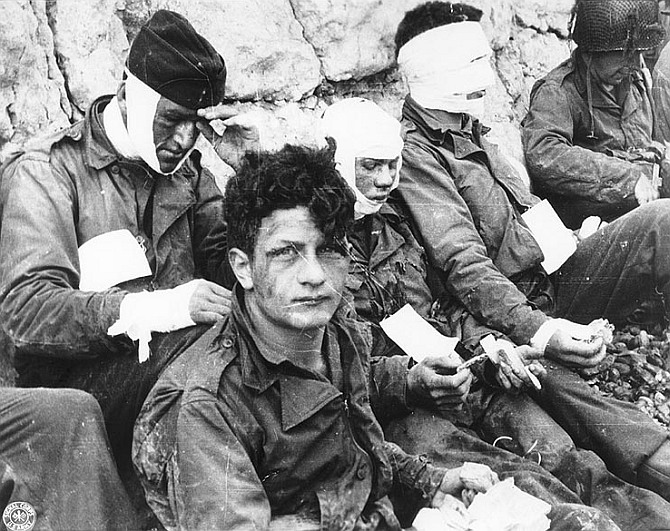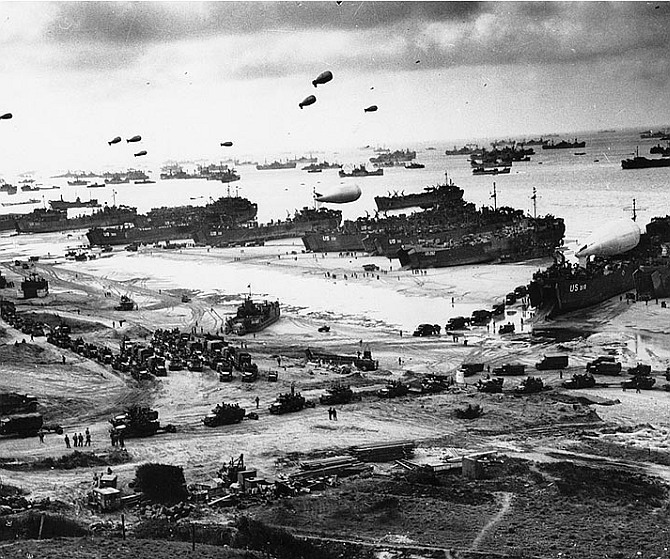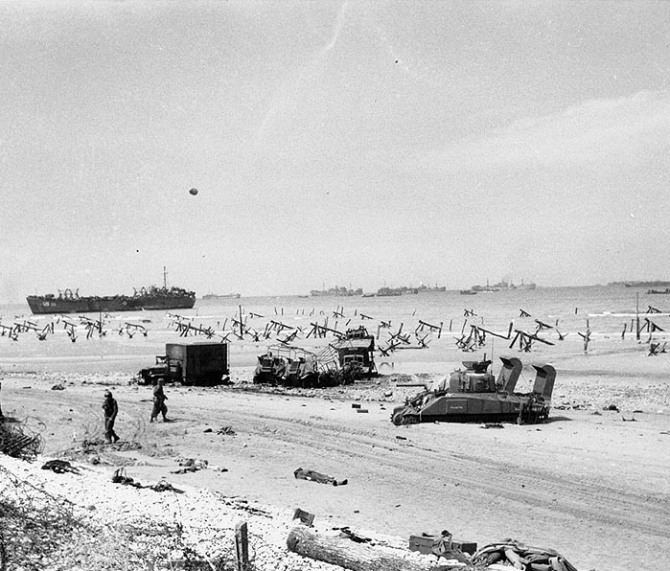 | « Back to article | Print this article |
This day in 1944: Hitler's downfall began
Seventy years ago on June 6, the beaches of Normandy in France were the site of an invasion never before, one that would change the course of history.
The successful Allied landing in France was a psychological blow to the German occupation of Europe in the Second World War. The balance of power on the continent, already weakened by Soviet offensives into Poland, was decisively tipped into Allied favour.
From that point on, the Allies would begin the drive into Germany that ultimately destroyed the Nazi regime on May 7, 1945.
Rediff.com narrates the story of how the D-Day unfolded on the beaches of Frances.
On June 6, 1944 the Western Allies landed in northern France, opening the long-awaited "Second Front" against Adolf Hitler's Germany during World War II.
Though they had been fighting in mainland Italy for some nine months, the Normandy invasion was in a strategically more important region, setting the stage to drive the Germans from France and ultimately destroy the National Socialist regime.
Click NEXT to read further...
This day in 1944: Hitler's downfall began
It had been four long years since France had been overrun and the British compelled to leave continental Europe, three since Hitler had attacked the Soviet Union and two and a half since the United States had formally entered the struggle.
After an often seemingly hopeless fight, beginning in late 1942 the Germans had been stopped and forced into slow retreat in eastern Europe, defeated in North Africa and confronted in Italy.
US and British bombers had visited ruin on the enemy's industrial cities. Allied navies had contained the German submarine threat, making possible an immense buildup of ground, sea and air power in the British Isles.
Schemes for a return to France, long in preparation, were now feasible. Detailed operation plans were in hand. Troops were well-trained, vast numbers of ships accumulated, and local German forces battered from the air.
Clever deceptions had confused the enemy about just when, and especially where, the blow would fall.
Click NEXT to read further...
This day in 1944: Hitler's downfall began
Commanded by US Army General Dwight D Eisenhower, the Normandy assault phase, code-named "Neptune" (the entire operation was "Overlord"), was launched when weather reports predicted satisfactory conditions on June 6.
On June 5, 1944, the thousands of ships and craft taking part in Operation NEPTUNE put to sea and began gathering in assembly areas southeast of the Isle of Wight.
Click NEXT to read further...
This day in 1944: Hitler's downfall began
In all, Britain, Canada, and the United States, as well as the navies-in-exile of France, the Netherlands, Norway, Poland and Greece, supplied 1,213 warships for the invasion.
Their main task was to provide shore bombardment firepower for the troops going ashore, to guard the transports, and to conduct minesweeping and antisubmarine patrols on the flanks of the invasion corridor.
The same navies also provided 4,126 amphibious craft, including a variety specialized landing craft, such as LSTs (Landing Ship, Tank), LCIs (Landing Craft, Infantry), and LCTs (Landing Craft, Tank [Rocket]).
More than 3,500 of these landing craft were actually used during the Normandy Invasion.
These amphibious craft would provide the crucial troop-carrying capacity to land the thousands of men, vehicles, and artillery along the 50-mile wide target area in the Bay of the Seine.
Click NEXT to read further...
This day in 1944: Hitler's downfall began
Following a brief bombardment by ships' guns, Soldiers of six divisions (three American, two British and one Canadian) stormed ashore in five main landing areas, named "Utah", "Omaha", "Gold", "Juno" and "Sword".
From there, many passed through the channels swept through the German defensive minefields and moved into their respective waiting areas before dawn on June 6.
Click NEXT to read further....
This day in 1944: Hitler's downfall began
Hundreds of anti-submarine escorts and patrol planes protected the flanks of these assault convoys.
Between 0530 and 0550, the Allied gunfire support task groups began bombarding prearranged targets along the beaches.
In the American sector, the landing at Utah beach began at 0630 and -- despite occurring slightly south of the target area -- proceeded according to plan as the US 4th division advanced rapidly toward its initial objectives.
Click NEXT to read further...
This day in 1944: Hitler's downfall began
At Omaha beach, where the landings began at 0635, underwater obstacles bottled up many of the amphibious craft and the congestion provided easy targets for German gunners.
The landing bogged down and it took a combination of short-range destroyer gunnery support, aerial bombardment and desperate infantry assaults to break the German defenses.
It was not until noon that the US 1st and 29th divisions crossed the beach line in force.
Click NEXT to read further...
This day in 1944: Hitler's downfall began
The British sector proceeded more smoothly. Despite rougher seas and higher-than-expected tides, which hindered the clearance of beach obstacles, excellent naval gunfire support kept German defensive fire suppressed at Sword and Juno beaches.
The landings there, which began at 0730 and 0735 respectively, proceeded apace and the British 3rd and Canadian 3rd divisions moved inland by early afternoon.
Click NEXT to read further...
This day in 1944: Hitler's downfall began
At Gold beach, where the 50th division landed at 0725, the beach obstacles were more numerous than expected and many landing craft were lost.
This hindered the buildup of forces ashore and it wasn't until nightfall that the beach was secured.
After overrunning the German beach defenses, the Allies rapidly expanded the individual beachheads, and the workhorse amphibious craft quickly reinforced the lodgment with new troops, munitions and supplies.
Click NEXT to read further...
This day in 1944: Hitler's downfall began
Superior Allied naval and shore-based artillery then helped defeat the initial German counter-attacks at the same time that Allied dominance of the air hindered the transportation of German reinforcements to the region.
By July 25, the allies were strong enough to launch Operation COBRA and begin the liberation of France.
With the Soviets advancing from the east, Hitler's armies were shoved, sometimes haltingly and always bloodily, back toward their homeland. The Second World War had entered its climactic phase.
Click NEXT to read further...
This day in 1944: Hitler's downfall began
The invasion of Normandy is considered the decisive battle of the war in Western Europe.
Before this battle the German Army still firmly occupied France and the low countries, the Nazi government still had access to the raw materials and industrial capacity of Western Europe, and local resistance to Nazi rule was disorganised and not very effective.
After the successful invasion of France and the expansion of the initial beachheads, the Allied armies moved over to the offensive.
Click NEXT to read further...
This day in 1944: Hitler's downfall began
The invasion proved a psychological and physical blow to German military fortunes from which they would never recover.

